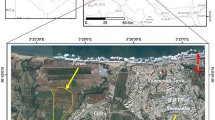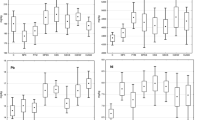Abstract
Purpose
Water shortage in most countries of the southern Mediterranean basin has led to the reuse of municipal wastewater for irrigation. Despite numerous advantages for soil fertility and crop productivity, recycling wastewater in the soil also has several ecotoxicological and sanitary problems. To evaluate the chronic soil contamination and the cumulative impact of wastewater, we compared seven plot sites irrigated with treated wastewater 1, 2, 7, 9, 13, and 15 years and one nonirrigated taken as control, and these were sampled for soil analysis.
Materials and methods
Soil samples were analyzed for pH, electrical conductivity (EC), total Kjeldahl nitrogen (TKN), total organic matter, and total concentrations of Cu, Zn, Fe, Ni, Pb, and Cd. Microbial biomass and enteric bacteria (fecal coliforms and fecal streptococci) were determined in all soil samples.
Results and discussion
The soil pH values were not consistently affected. Soil salinity, measured as EC, appeared significantly high and proportional to the duration of wastewater irrigation. Also, concentrations of total Ni, Zn, Cu, Pb, and Cd increased significantly (P ≤ 0.05) according to the number of irrigation years but are usually under Tunisian standards. The concentration of heavy metals (Ni, Zn, Cu, Pb, and Cd) showed a significant decrease in the soil profile. The microbial biomass carbon (MBC) is 1.5 times larger in the soil irrigated for 15 years with treated wastewater as compared to the one taken as control. The growth of microorganisms might be explained by the ready source of easily degradable compounds in the oligotrophic soil environment brought about by wastewater irrigation. Soil bacteriological analysis showed that the number of fecal coliforms (FC) and that of fecal streptococci (FS) were affected appreciably (P ≤ 0.05) by the duration of wastewater application (number of years) and by the soil depth (0–20, 20–40, and 40–60 cm).
Conclusions
Treated wastewater irrigation led to changes in physicochemical and microbiological soil properties. The magnitude and specificity of these changes significantly correlated with the duration of such practice. It can be concluded, based on these results, that the proper management of wastewater irrigation and periodic monitoring of soil fertility and quality parameters are required to ensure successful, safe, and long-term reuse of wastewater irrigation.





Similar content being viewed by others
References
Al-Lahham O, El Assi NM, Fayyad M (2003) Impact of treated wastewater irrigation on quality attributes and contamination of tomato fruit. Agric Water Manage 61(1):51–62
Alloway BJ, Ayres DC (1993) Chemical principles of environmental pollution. Blackie Academic and Professional, an imprint of Chapman and Hall, Oxford
APHA (1998) Standards methods for the examination of water and wastewater, 20th edn. American Public Health Association, Washington, DC
Ayres RS, Westcot DW (1985) Water quality agriculture. FAO irrigation and drainage paper 29, rev. 1. FAO, Rome, p 174
Bohn HL, McNeal BL, O’Connor AG (1985) Soil chemistry, 2nd edn. Wiley-InterScience, New York, p 341
Brar MS, Khurana MPS, Kansal BD (2002) Effect of irrigation by untreated sewage effluents on the micro and potentially toxic elements in soils and plants. Proc 17th World Congress Soil Sci 198(4):1–10, Bangkok, Thailand
Brookes PC, Landman A, Pruden G, Jekinson DS (1985) Chloroform fumigation and the release of soil nitrogen: a rapid direct extraction method to measure microbial biomass nitrogen in soil. Soil Biol and Biochem 17(6):837–842
Candela L, Fabregat S, Josa A, Suriol J, Vigués N, Mas J (2007) Assessment of soil and groundwater impacts by treated urban wastewater reuse. A case study: application in a golf course (Girona, Spain). Sci Total Environ 374:26–35
Chen Z, Zhao Y, Li Q, Qiao J, Tian Q, Liu X (2009) Heavy metal contents and chemical speciations in sewage-irrigated soils from the eastern suburb of Beijing, China. J Food Agric Environ 7:690–695
County Sanitation Districts of Los Angeles County (2004) Palmdale water reclamation plant annual monitoring report. Monitoring & reporting program nos. 6-00-57-A01, 6-00-57-A02 and 6-00-57-A03
Gwenzi W, Munondo R (2008) Long-term impacts of pasture irrigation with treated sewage effluent on nutrient status of a sandy soil in Zimbabwe. Nutr Cycl Agroecosyst 82:197–207
Huertas E, Salgot M, Hollender J, Weber S, Dott W, Khan S, Schafer A, Messalem R, Bis B, Aharoni A, Chikurel H (2008) Key objectives for water reuse concepts. Desalination 218:120–131
Jedidi N, Hassen A, VanCleamput O, M’Hiri A (2004) Microbial biomass in a soil amended with different types of organic wastes. Waste Manag Res 22(2):93–99
Kao P, Huang C, Hseu Z (2006) Response of microbial activities to heavy metals in a neutral loamy soil treated with biosolid. Chemosphere 64:63–70
Klay S, Charef A, Ayed A, Houman B, Rezgui F (2010) Effect of irrigation with treated wastewater on geochemical properties (saltiness, C, N and heavy metals) of isohumic soils (Zaouit Sousse perimeter, Oriental Tunisia). Desalination 253:180–187
Lejon DPH, Sebastia J, Lamy I, Nowak V, Chaussod R, Ranjard L (2007) Relationship between soil organic status and microbial density and genetic structure in two agricultural soils submitted to various organic managements. Microb Ecol 53:650–653
Levine AD, Asano T (2004) Recovering sustainable water from wastewater. Environ Sci Tech 38(11):201A–208A
Macino CF, Pepper IL (1992) Irrigation of turf-grass with secondary sewage effluent: soil quality. Agron J 84(4):650–654
Mapanda F, Mangwayana EN, Nyamangara J, Giller KE (2005) The effect of long-term irrigation using wastewater on heavy metal content of soil under vegetables in Harare, Zimbabwe. Agr Ecosyst Environ 107:151–165
Mekki A, Dhouid A. Sayadi S (2006) Changes in microbial and soil properties following amendment with treated and untreated olive mill wastewater. Microbiol Res (161):93–101
Mohamed MJ, Mazahreh N (2003) Changes in soil fertility parameters in response to irrigation of forage crops with secondary treated wastewater. Soil Sci Plant Nutr 34(9–10):1281–1294
Palese AM, Pasquale V, Celano G, Figliuolo G, Masi S, Xiloyannis C (2009) Irrigation of olive groves in southern Italia treated municipal wastewater: effects on microbiological quality of soil and fruits. Agr Ecosyst Environ 129:43–51
Pescod MB, Arar A (1988) Treatment and use of sewage effluent for irrigation. Butterworths, London
Ramirez-Fuentes E, Lucho-Constantino C, Escamilla-Silva E, Dendooven L (2002) Characteristics, carbon and nitrogen dynamics in soil irrigated with wastewater for different lengths of time. Bioresource Technol 85(2):179–187
Rosabal A, Morillo E, Undabeytia T, Maqueda C, Justo A, Herencia JF (2007) Long-term impacts of wastewater irrigation on Cuban soils. Soil Sci Soc Am J 71:1292–1298
Shetty S (2004) Treated wastewater use in Tunisia: lessons learned and the road ahead. In: Scott CA, Faruqui NI, Raschid-Sally L (eds) Wastewater use in irrigated agriculture: confronting the livelihood and environmental realities. CABI, Oxford, pp 163–172
Siebe C (1995) Nutrient inputs to soils and their uptake by alfalfa through long-term irrigation with untreated sewage effluent in Mexico. Soil Use Manag 14(2):119–122
Tarchouna LG, Merdy P, Raynaud M, Pfeifer H, Lucas Y (2010) Effects of long-term irrigation with treated wastewater. Part 1: evolution of soil physico-chemical properties. Appl Geochem 25:1703–1710
WHO (1989) Health guidelines for the use of wastewater in agriculture and aquaculture: report of a WHO Scientific Group. WHO Technical Report Series 778. World Health Organization, Geneva, p 74
Xu J, Wu L, Chang A, Zhang Y (2010) Impact of long-term reclaimed wastewater irrigation on agriculture soil : preliminary assessment. J Hazard Mater 183:780–786
Acknowledgments
The authors would like to thank Bouzaine Olfa for her excellent technical assistance. The present study is a part of the 1999–2006 research programs which is supported by the Tunisian Ministry of High Education, Scientific Research and Technology.
Author information
Authors and Affiliations
Corresponding author
Additional information
Responsible editor: Jizheng He
Rights and permissions
About this article
Cite this article
Hidri, Y., Fourti, O., Eturki, S. et al. Effects of 15-year application of municipal wastewater on microbial biomass, fecal pollution indicators, and heavy metals in a Tunisian calcareous soil. J Soils Sediments 14, 155–163 (2014). https://doi.org/10.1007/s11368-013-0801-4
Received:
Accepted:
Published:
Issue Date:
DOI: https://doi.org/10.1007/s11368-013-0801-4




